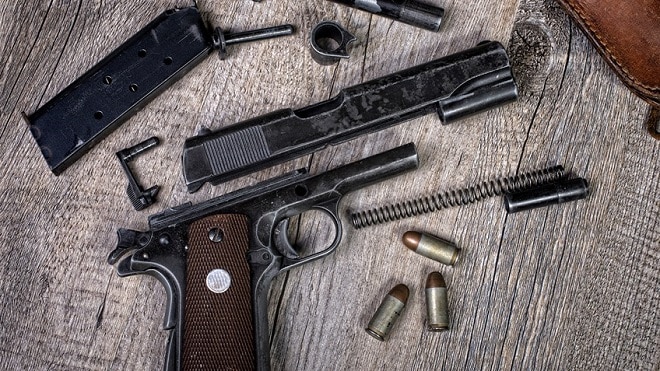An add-on to the 2016 National Defense Authorization Act coming up in the Senate includes a plan to transfer the U.S. Army’s remaining stock of .45 ACP 1911A1 pistols to the Civilian Marksmanship Program.
Setting spending policy for $612 billion in funds for the Department of Defense, the “must-pass” bill pushed through the House on Thursday in a 270-156 vote and is expected to be taken up for a final roll call in the Senate this week, where an earlier version passed 71-25 in June, then it’s on to President Obama’s desk.
Introduced in April, the NDAA has seen a varied 621 amendments tacked on, including everything from prohibiting the listing of the Lesser Prairie Chicken as a threatened or endangered species until 2021, to providing post-traumatic stress disorder training to military and security forces of the Government of Ukraine, to allowing troops to carry personal firearms while on base.
One of those myriad of amendments is one by Rep. Mike Rogers, R-Ala., that could see potentially the largest remaining stock of military surplus World War II-era handguns in government hands sold to the public through the CMP, a federally chartered non-profit corporation tasked with promoting firearms safety training and rifle practice.
“We worked long and hard on this crucial piece of legislation,” Rogers said in a statement Thursday. “I am proud it passed the House with my strong support and am pleased our military is funded to help keep our nation safe. I am very pleased with the CMP amendment and the inclusion of the language to take care of the Depot. I hope the Senate will quickly pass this legislation so it can go to President Obama to be signed into law.”
The military currently stores 100,000 Model 1911 .45ACP handguns that are surplus to the Army’s needs. The guns, remnants of more than two million produced for the Army between 1912 and 1945, were withdrawn from service in the 1980s but cannot, by law, be cleared for disposal.
The amendment would authorize the CMP, currently just limited to selling .30 and .22-caliber rifles, to receive and sell any surplus military firearm. It would not cover any surplus 1911s held by other branches such as the Navy and Air Force, or those that may linger in federal law enforcement service.
The Army guns are stored at the Anniston Army Depot, in a district which Rogers represents and is coincidentally co-located to the CMP’s regional warehouse and store, which would minimize the logistics of a transfer.
However, an Army whitepaper released in May, prompted by the Department of Justice, questions the plan to pass the unwanted guns to taxpayers while casting doubts on expanding the CMP’s current mission to allow it to sell surplus handguns overall. While the program sold them in the 1960s, it has not done so since breaking away from the Army itself in the 1990s.
“There is a significant risk of approximately 100K semiautomatic handguns that are virtually untraceable, being released into commerce,” the paper reads. “Per DOJ, M1911 pistols are popular crime guns. Over the last 10 years, they traced an average of 1,768 M1911 pistols with a significant percentage (percentage not provided) ultimately identified as surplus U.S. military firearms.”
The CMP is optimistic the measure will earn presidential signature, but warns the process to get the guns offered to the public will not occur overnight.
“If signed, we will meet with the Army to develop procedures,” wrote CMP Chief Operating Officer Mark Johnson in a statement sent to Guns.com Friday. “All of this will take time. We have no further information. When information becomes available we will communicate with our customers.”
Gun collectors are cautiously hopeful the vintage historical firearms will be released to the public.
“The guns would be prized collectibles and much less likely to be misused than the vast majority of firearms on the market today (legal or otherwise),” Bruce N. Canfield, a noted firearms historian and author of numerous books on post-Civil War weaponry, told Guns.com. “Let’s hope the politicians use common sense for a change and not cave in to political expediency or pressure from opponents of the Second Amendment.”
Rocky waters ahead
As for the NDAA itself, the president has promised a veto if it reaches his desk in its current form, largely due to its provision for $90 billion in special war funds to allow the Pentagon to avoid mandatory “sequestration” budget cuts.
“That’s an irresponsible way to fund our national defense priorities,” White House spokesman Josh Earnest said Wednesday. “If the president got this bill, he’d veto it.”
This could set up an election year showdown with a lame duck Democratic president against a GOP-controlled Congress
Sen. John McCain, R-Ariz., the ranking member of the Senate Armed Services Committee, had harsh words for the veto threat of legislation that only sets policy, not authorizes funds.
“The White House’s announcement that President Obama will veto the National Defense Authorization Act is shameful. The NDAA is a policy bill,” said McCain in a statement. “If the president vetoes the NDAA, at this time of mounting global threats, he will be prioritizing politics and process over the security of our nation and the well-being of our Armed Forces.”
The post Plan to sell milsurp 1911s through CMP one step from White House appeared first on Guns.com.

